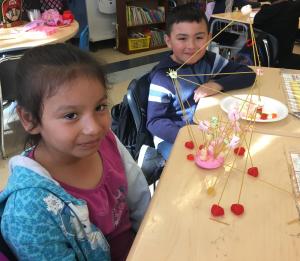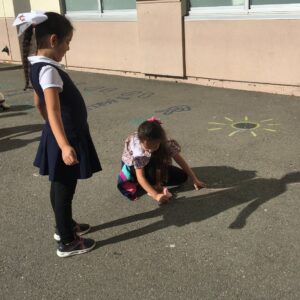Science Super Star: Ana Laredo
April 6, 2020
We are honored to recognize Ana Laredo, a 1st Grade Teacher at Downer Elementary in San Pablo, as a 2020 Science Super Star!
Ana incorporates science across the subjects and builds connections to her students’ daily lives. For one science unit this year, Ana engaged her students in exploring the solubility process of many of their favorite holiday sugary sweets: candy-canes and sweethearts. By taking a closer look at items that most of her students were very familiar with, she was able to help them question the processes of the world around them.
After introducing the phenomenon of candy dissolving (based on students’ experiences!), Ana asked her students use their prior knowledge to make some predictions about their experiment candies would change shape, color, grow in size, and sink or float, based on of what they had experienced in their lives. They tested their predictions by dropping candy canes and hearts in various liquids at varying temperatures, and observing what processes occurred. Students tracked their observations and data over the course of three days. Many were shocked to find that the candies sank rather than floated, while others were happy to see their predictions about the candies changing shape were correct. Ana challeged the students to not only note what they saw, but to try to explain “why” the change happened. She was pleased and surprised to hear the variety of ideas the students shared with one another. She noted the young scientists’ growing skill in using a sentence frame that included both the observation and a reasoning, such as: “the candy dissolves in hot water faster because it has sugar.”
After allowing her students to take charge and conduct their experiments, she noticed a confidence in her students, in both the ability to make 
| “My newcomer student, who does not speak English and hesitates to interact with her partners, was the student who built the highest and strongest structure with marshmallows and spaghetti. She was so proud! I told her she is a great engineer like Rosie Revere.” |
Ana encourages her young learners to keep track of their ideas and predictions in their science journals, and reminds them to make use of the new words they learn during the experiment. She has found that they now have the ability to apply scientific terms that have learned through experiments into their lives outside of the classroom. In addition to writing sentences, Ana encourages her students to share their ideas and results using visuals such as graphs, sketches, and timelines, measurements, compare & contrast charts, and prediction charts. This allows her to quickly assess her students’ evolving understanding of the science concepts as well as see how they apply their developing language arts communication skills.
Ana offers helpful advice for her fellow teachers looking to get started, or to go deeper, with science:
| “Make science lessons fun! Let students participate in the whole process. Use multiple resources such as CRS, FOSS, Mystery Science, etc. Try to relate the topic to their own lives. Do activities inside and outside of class. Share with your coworkers.” |

